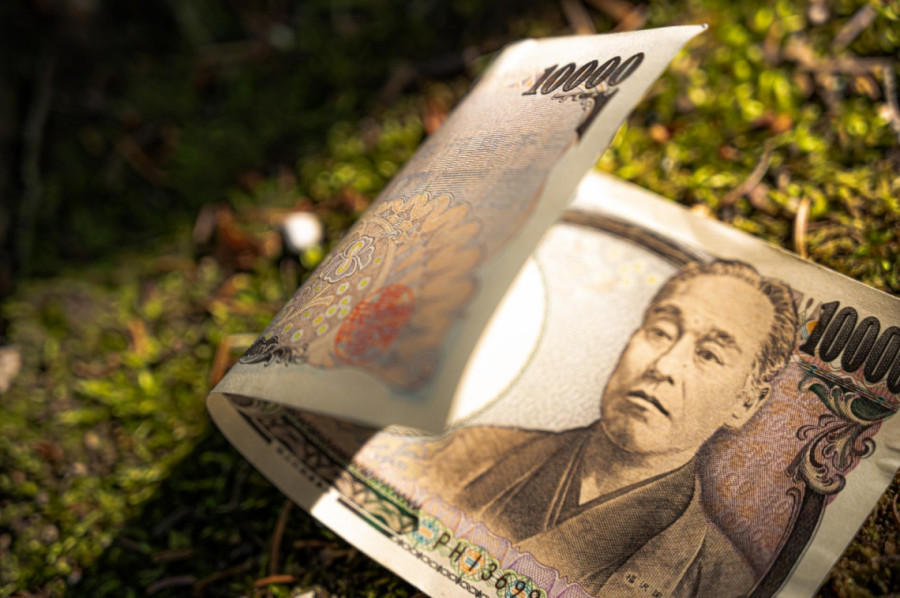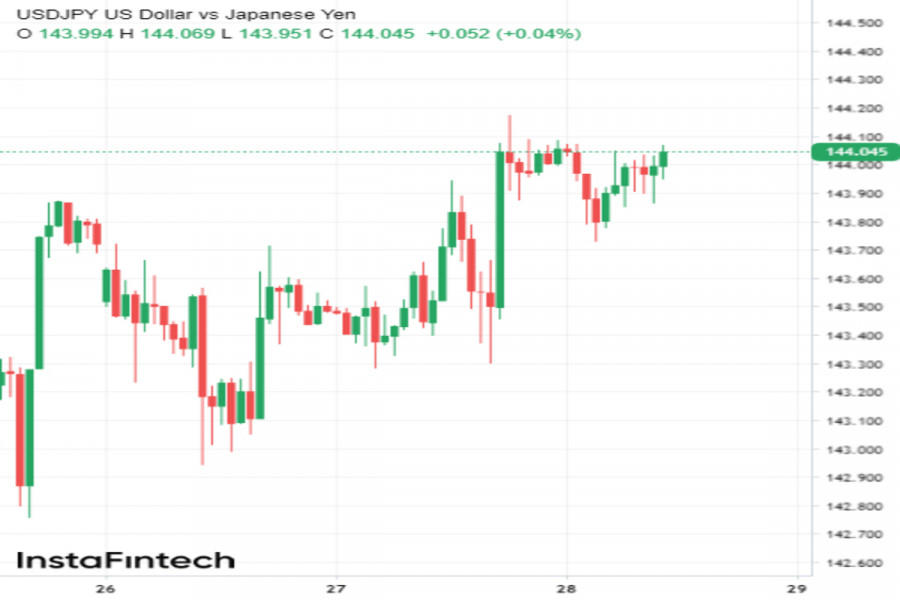Since the start of the year, the Japanese yen has depreciated against the US dollar by more than 8%. The yen's position has been particularly shaken in the past month, fuelled by growing market expectations regarding the deepening rate differential between Japan and the United States. Will Tokyo take measures to save the yen or is a weak currency not necessarily a negative factor for Japan's economy?
JPY dynamics and short-term forecast
On Tuesday, USD/JPY increased by almost 0.4% despite the overall weakness of the US dollar. The pair managed to cross the key level of 144 and reach its highest level since November 10, hitting 144.18.
The pair was bolstered by robust US macroeconomic data, which reinforced traders' belief that the Federal Reserve will resume raising rates in July, increasing the rate by 25 basis points. Currently, the likelihood of this scenario is estimated at 77%.
The Conference Board research company reported yesterday that the level of consumer confidence in the US grew this month to 109.7, significantly higher than the forecasts of 103.9 and above the May value of 105.
Meanwhile, a report from the US Department of Commerce also turned out to be positive. It showed that in May, orders for durable goods went up from 1.2% to 1.7% year-on-year, whereas a reduction to -1% had been predicted.
The US housing market data also pleased the dollar bulls. According to it, new home sales unexpectedly jumped from 3.5% to 12.2% last month, reaching 763,000 units against the April reading of 680,000.
As we can see, the US economy continues to stand strong despite the ongoing tightening of monetary and credit conditions in the country, which instills optimism in market participants about the continuation of the Fed's aggressive policy.
The prospect of further rate increases in the US, when the Bank of Japan continues to adhere to an ultra-soft monetary policy and keeps its rate in negative territory, is a powerful driver for the USD/JPY pair.
Analysts predict that in the short term, the pair will maintain the uptrend. Today, the currency pair may be supported by comments from Fed Chairman Jerome Powell and his Japanese counterpart Kazuo Ueda.
However, the rise is likely to be limited by the increasing risk of intervention from the Japanese government. On Wednesday morning, the USD/JPY pair started a downward correction as Tokyo once again repeated its warning.
Let's figure out what is the probability that the Japanese authorities will continue to protect their national currency and which scenario for saving the JPY from further devaluation looks most realistic at this stage.
1. Escalation of verbal intervention
Since last week, when Fed Chairman Jerome Powell hinted at additional tightening, the yen has been in a freefall against the dollar. Since then, Japanese officials have had their hand on the red button, issuing daily threats against speculators attempting to profit from discrepancies in the monetary policy of the Fed and BOJ by buying the USD/JPY pair.
Considering that the fundamental backdrop for the yen is unlikely to change in the near future, it can be assumed that traders will continue actively selling the Japanese currency.
If the rate of decline in JPY accelerates, Tokyo may intensify its warnings, promising to take decisive action against speculative movements. Most experts consider this scenario as the most probable one.
"The yen doesn't have the same falling momentum as last year. as the United States approaches the peak of interest rates. There will probably be one or maybe two more hikes. As we can see, the current situation is not as critical for the Japanese currency as it was a year ago when the Federal Reserve was just starting to tighten monetary policy. Therefore, at this stage, we do not expect strong JPY volatility towards depreciation," shared economist Atsushi Takeda from the Itochu Research Institute.
The Japanese government has repeatedly stated that it is focused on the pace of currency depreciation rather than any specific target. Therefore, analysts believe that Tokyo will continue its verbal intervention as the USD/JPY pair approaches the level of 145 but is unlikely to initiate actual market intervention if speculators cross that threshold.
2. Conducting intervention
Last year, the Japanese government intervened in the market twice: in September when the yen fell against the dollar to almost 146 and in October when USD/JPY approached a 32-year high at 152.
Japan spent $65 billion on direct JPY purchases in 2022. A new intervention will also be very costly for Tokyo as authorities will have to use the country's foreign exchange reserves to sell dollars.
"Businesses and consumers are more tolerant of the weak yen now than they were last year...the recent rally in Japanese stocks may also be helping their mood," according to Taro Kimura, an analyst at Bloomberg Economics.
Given this fact, as well as the benefit of the weakening yen for exporters, experts consider the implementation of a real intervention at this stage to be unlikely
Japanese companies with a global presence have long been the biggest beneficiaries of a cheap JPY, a factor that increases their overseas earnings. Thanks to the weak exchange rate, Toyota added 1.3 trillion yen to its annual operating profit, and Sony was able to increase sales in five key segments by approximately 1.2 trillion yen.
"We believe the government will only intervene in the market if the yen suddenly falls to 150. Although they did it last year, currency intervention is still the last option," said Hideo Kumano, an analyst at the Dai-Ichi Life Research Institute.
3. BoJ's hawkish step
Some market participants suggest that the Bank of Japan could halt the current yen decline by adjusting its Yield Curve Control (YCC) policy. The expectation that the BoJ will make its first hawkish move as early as July is gaining ground. However, Bloomberg analysts believe this expectation is misplaced.
"The BoJ has repeatedly stated that it does not intend to use monetary policy tools to directly curb the yen's depreciation as this step exceeds its mandate and could be construed as currency manipulation," shared Toru Fujioka, an economic commentator.
According to the expert, the Bank of Japan will only decide on a YCC adjustment if the bond market starts to fluctuate wildly again as it did last year and if inflation in the country becomes persistent due to wage increases.
"In July, the central bank will likely revise its inflation forecast for this fiscal year upwards, but its monetary policy will remain unchanged as the BOJ probably wants to look at the outcome of summer bonus payments. Uncertainty over the overseas economic outlook is also a good reason to wait," said Makoto Sakurai, a former member of the BoJ's board, in an interview with Reuters on Tuesday.
According to his forecasts, the key moment when the Bank of Japan will introduce long-awaited changes to the YCC mechanism will come around October or December this year.
As we can see, the scenario implying a strengthening of the yen due to a YCC adjustment is currently the least likely.
Conclusion
Given that the fundamental background for the yen remains extremely unfavorable, most analysts see the potential for its further decline against the dollar. However, it should be noted that the speed of its decline will likely be limited by growing concerns about possible intervention.
An escalation of verbal intervention by the Japanese government is the primary risk for the USD/JPY pair at this stage. At the same time, actual market intervention does not pose a significant threat at present.













